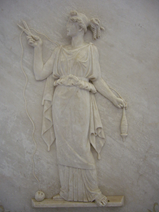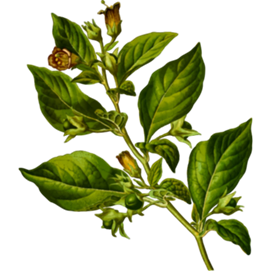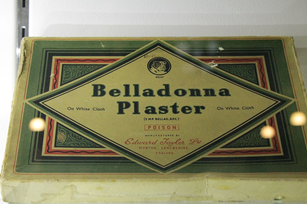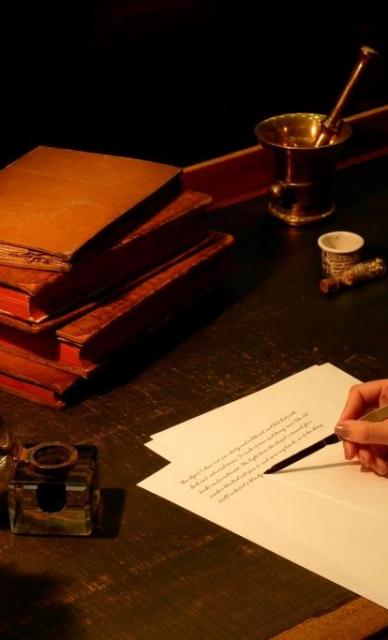Physicians' Gallery Newsletter
Updates on upcoming events, exhibitions and online stories
Empowering medical excellence, shaping healthcare futures.
Atropa belladonna is more commonly known as the deadly nightshade and is possibly one of the most famous dangerous plants. It has a long and twisted history of various medicinal, murderous, and cosmetic uses and sometimes plays quite sinister roles in folklore and legends.
The deadly nightshade is one of many ‘siblings’ within the Nightshade family (Solanaceae) and is related to the mandrake, another plant followed by various myths. It is not clear where exactly the name Nightshade comes from, although it could possibly be connected to some of the related plants’ preference for growing in shady places or flowering at night. One of the earliest recorded mentions of the family was made by the so-called “father of botany” Theophrastus, who wrote the first Greek treatise on plants around c. 230 BC. He recommended the mandrake (mandragora), a fellow member of the Nightshade family, as a remedy for sleeplessness and gout, but also as an ingredient for a love potion.

Deadly Nightshade did not receive its ‘official’ botanical classification’s name until Carl Linnaeus’ revolutionary new system in the mid-1700s: Atropos is the name of one of the three Fates in Greek mythology, the goddesses in charge of ending a life. One spins the thread of life, one measures it, and one - Atropos - cuts it. Belladonna means ‘beautiful woman’ in Italian and refers to a common cosmetic practice during the Renaissance, in which women used the plant to dilate their pupils, making their eyes look bigger. Atropa belladonna is also distantly related to the potato, the eggplant, bell peppers, and tobacco to name just a few.
One of the most famous associations of the Deadly Nightshade is its connection to mythology, folklore and witchcraft. In antiquity, the plant was associated with the cult of Dionysus, the Greek god of wine and ecstasy, and it was allegedly mixed for a drink that could induce a trance in worshippers. On a more sinister note, it also features in the myth of Odysseus, whose men were - legend has it - poisoned with nightshade and then turned into pigs by the witch Circe.
In times of the Roman Empire, Deadly Nightshade was rumoured to be Livia’s ‘weapon of choice’ to poison her husband, the Emperor Augustus. Allegedly, the Roman troops also coated arrow-heads with a paste made from the plant to poison their enemies.

Deadly Nightshade featured heavily in so-called witches’ ingredients and was closely associated with the Devil. For example, parents on occasion told their children that if they ate the plant’s berries they would meet the Devil in person - this was a tale told to help them avoid the berries. It was also apparently one of the ingredients that allowed witches’ to fly, something they experienced in hallucinations caused by a combination of plants.
From around the 1600s onwards, there was an increase in scientific and botanical study of the Deadly Nightshade and from the late 1700s it was a regular feature in pharmacopoeias (a publication listing medicinal drugs). While it was well-known that it was poisonous, some medicinal benefits were found by physicians. For example, in 1803 Edinburgh’s own Andrew Duncan described the uses of Atropa - in the form of powdered leaves or roots - for conditions such as epilepsy, mania or melancholy.

In 1813, the alkaloid (an organic compound that has a strong effect on humans) atropine was isolated from the plant and with this, poisonings could occur both on purpose or by accident. In the 1950s, it was even incorporated into the Belladonna Plasters, which were available over the counter and were used for conditions ranging from rheumatism to pulmonary tuberculosis. Nowadays, atropine and related products are not easy to find although occasionally eye surgeons still use very small amounts during surgery to enlarge the pupils.
Author: Isabel Lauterjung
References and further reading:
- Lee, MR. 2006. “The Solanaceae II: The mandrake (Mandragora officinarum); in league with the Devil”, in Journal of the Royal College of Physicians Edinburgh, Vol. 36, pp.278-285
- Lee, MR. 2007. “Solanaceae IV: Atropa belladonna, Deadly Nightshade”, in Journal of the Royal College of Physicians Edinburgh, Vol. 37, pp.77-84
- https://www.britannica.com/topic/list-of-plants-in-the-family-Solanacea…
- https://www.rdalchemy.com/blogs/news/17946247-deadly-nightshade-atropa-…
- http://poisonousnature.biodiversityexhibition.com/en/card/deadly-nights…
- https://www.icysedgwick.com/folklore-of-flowers/
- https://www.ambius.com/blog/botany-gone-bad-the-history-of-the-deadly-n…
- https://www.fs.fed.us/wildflowers/ethnobotany/Mind_and_Spirit/belladonn…
Image sources:
https://commons.wikimedia.org/wiki/File:Atropos.jpg [CC BY-SA 3.0]
https://freesvg.org/deadly-nightshade [Public Domain licence]
https://commons.wikimedia.org/wiki/File:A_belladonna_plaster,_Hunterian… [Creative Commons Attribution-Share Alike 4.0 International licence]

Updates on upcoming events, exhibitions and online stories